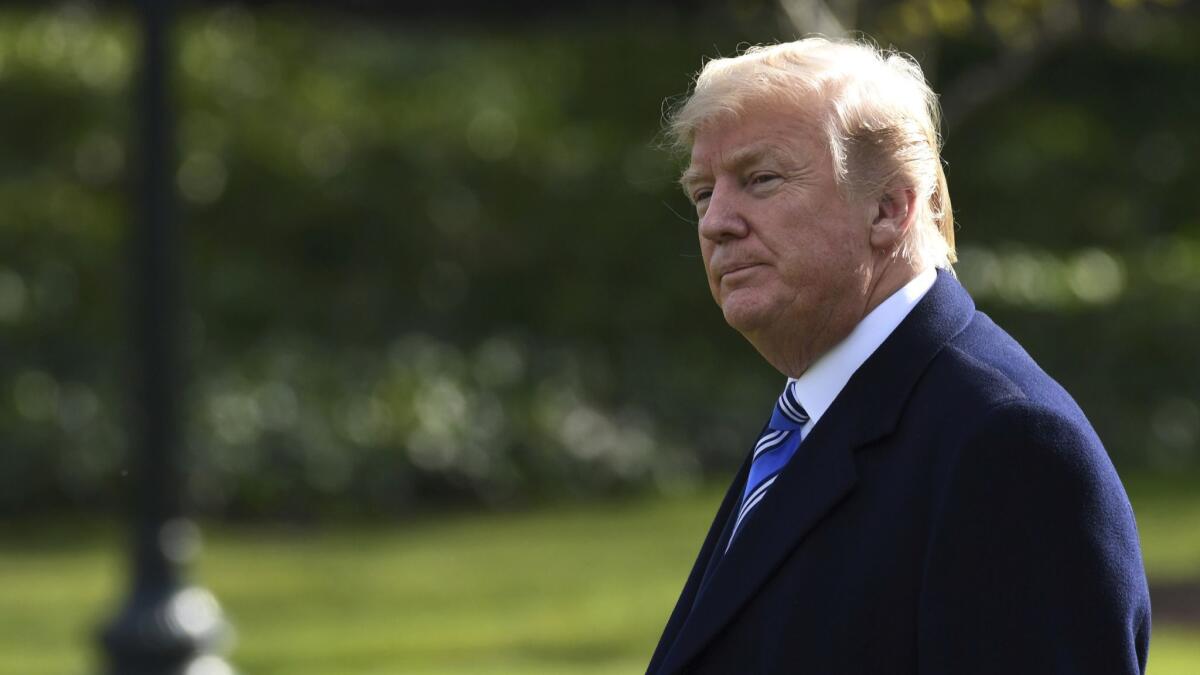Trump closes his first trade deal, a modest step with South Korea

Reporting from Washington — The U.S. and South Korea have reached an agreement in principle to amend a decade-old free-trade pact that President Trump used to call “horrible” and a “disaster” — his first such deal and a victory, albeit a modest one, for his toughened approach to America’s economic partners.
Under the deal, South Korea agreed to limit its steel exports to the U.S. and made concessions on auto imports. In return, the U.S. agreed to exempt South Korea from the 25% tariff on steel that Trump announced this month.
The deal removes a major point of friction between the two allies at a moment when they’re preparing for negotiations with North Korea about its nuclear program. Relations between the U.S. and South Korea have been strained at several points in the last year as Trump has railed against an $18-billion trade deficit and denounced the U.S.-Korea Free Trade Agreement, known as Korus.
Trump has called Korus a “horrible” agreement that “destroyed” U.S. industry. A year ago, he threatened to terminate the whole agreement, which was negotiated under President George W. Bush in 2007 but not ratified until five years later under President Obama.
The new amendments to the trade deal will mark modest concessions by a trading partner that is a relatively small player behind the European Union, China and Canada.
The amendments do not directly address some major trade issues between the two countries, including agriculture.
But Trump administration officials boasted of it as a major victory, one that “validates President Trump’s visionary approach,” as a senior administration official told reporters Tuesday. The agreement is an example of “the president fulfilling promises he made during the campaign,” said one senior advisor, adding that it amounts to economic “success across the board.”
Earlier, a statement from the Blue House, the home of the South Korean president, called the deal a “win-win,” echoing a phrase used over the weekend by Treasury Secretary Steven T. Mnuchin.
Administration officials, briefing reporters on condition that they not be named, specifically predicted that the agreement would increase the number of American automobiles and auto parts sold in South Korea. The trade deficit in autos accounts for the lion’s share of the overall deficit with South Korea.
In addition to the agreement on autos, the South Korean trade ministry announced Monday that it would accept a new quota on steel shipped to the U.S. that equaled about 70% of its annual average over the last three years.
The quota, the administration officials said, was a key part of the agreement to exempt South Korea from the steel tariff. It’s designed to eliminate the problem of “transshipment”: South Korean companies buying steel from elsewhere, especially China, and sending it to the U.S. South Korea is the third-largest exporter of steel to the U.S.
Under the agreement, South Korea will begin to recognize U.S. standards for auto parts and reduce other requirements that raised the cost of U.S. cars. The changes will “make it easier for our American companies to compete on a level playing field,” one senior administration official said.
Whether the deal will live up to that promise is uncertain, however. Currently, U.S. automakers in effect face a cap on the number of vehicles they can sell in South Korea. The deal raises that cap by requiring the South Koreans to accept U.S. safety standards rather than impose their own. But U.S. vehicle sales have run far below the existing limit, so it’s unclear whether raising the cap will greatly change the picture.
The deal also extends until 2041 a U.S. tariff on pickup trucks. The old trade agreement called for that tariff to be phased out in 2021.
Extending the tariff reflects Trump’s preference for protecting U.S. industries rather than lowering overall trade barriers. The extra 20 years of protection for U.S. manufacturers will preserve American jobs, the administration officials said.
But there too the exact impact is unclear. South Korea’s big automakers, Kia and Hyundai, are not major exporters of trucks to the U.S. The tariff, however, would give the two companies a powerful incentive to base production in the U.S. rather than South Korea if they decide to expand in the U.S. truck market.
Trump bolstered his threat to upend trade deals early on by withdrawing the U.S. from the Trans-Pacific Partnership that Obama negotiated with 11 Asian and Latin American nations. Trump said he would turn his attention to crafting bilateral deals.
As part of those negotiations, he has used the steel and aluminum tariffs, which he announced with considerable fanfare in early March, as bargaining chips.
He early on said Canada and Mexico would be exempt while the U.S. negotiates with them to revise the North American Free Trade Agreement. More recently, administration officials have said that in addition to those two countries and South Korea, they would also exempt the members of the European Union, Argentina, Australia and Brazil. What concessions, if any, those countries will make in exchange remains unclear.
The result has been to leave well over half of U.S. imports of both steel and aluminum clear of the new tariffs. Administration officials said South Korea would be exempt from the steel tariff, but not the new levy on aluminum. South Korea, however, is not a major exporter of aluminum to the U.S.
The two countries also are closing in on a deal to limit currency manipulation, the practice of a country deliberately reducing the value of its currency to improve its trade performance.
Under the agreement, being negotiated by the Treasury Department and the South Korean finance ministry, the South Koreans would commit to new rules on transparency. But the administration officials acknowledged that because the currency agreement would be a side deal, not part of the actual trade agreement, it has no real means of enforcement.
Twitter: @cparsons
More to Read
Get the L.A. Times Politics newsletter
Deeply reported insights into legislation, politics and policy from Sacramento, Washington and beyond. In your inbox three times per week.
You may occasionally receive promotional content from the Los Angeles Times.











